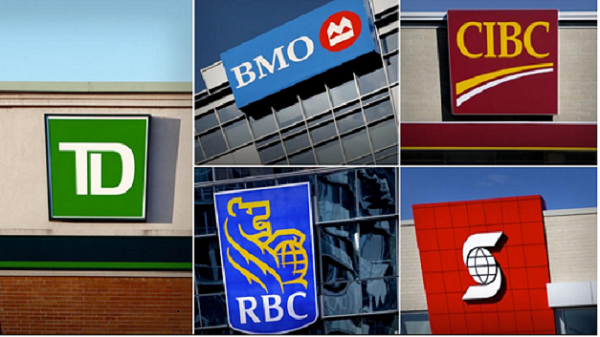Investors on the lookout: Bank loans in focus as rising arrears, slow growth could weigh on profits
The spotlight is squarely on the health of the large Canadian banks’ loan books as they get ready to report fiscal third-quarter results over the next week, with the pace of growth likely to be sluggish and investors watching for signs that the risk of defaults is rising.
Analysts expect credit portfolios to show signs of mounting strain as unemployment rates in Canada and the United States tick higher, and as high borrowing costs weigh more heavily on consumers and businesses. Profit margins on loans are expected to largely hold steady.
The large banks’ earnings per share will climb modestly higher, analysts expect, rising by 2 to 3 per cent for the quarter that ended July 31, when compared with the same period a year earlier. They are anticipating a boost to profit from wealth management and solid results from capital markets.
But rising provisions for credit losses – the reserves that banks set aside to cover potential losses if loans go bad – are the wild card that could decide whether the reaction to the banks’ performance turns positive or pessimistic.
“Credit experience will ultimately determine which way the group trades and will likely distinguish the winners from the losers,” said Paul Holden, an analyst at CIBC World Markets Inc., in a Monday note to clients.
Toronto-Dominion Bank is first to report earnings, on Thursday. The rest of the Big Six banks follow next week, with Bank of Nova Scotia and Bank of Montreal reporting on Aug. 27, Royal Bank of Canada and National Bank of Canada on Aug. 28 and CIBC wrapping up earnings season on Aug. 29.
Raw numbers aside, there is also an appetite for updates on larger strategic themes that will shape investors’ feelings about the sector.
RBC is still digesting its $13.5-billion purchase of HSBC Bank Canada, and is set to report its first full quarter including new revenue from the integrated bank. National Bank of Canada is working to secure shareholders’ approval for its proposed deal to buy Canadian Western Bank for $5-billion. Scotiabank is sure to face more questions about its surprising $2.8-billion investment in U.S. regional bank KeyCorp, which was met with skepticism.
And all eyes are on TD, where the prospect of stiff penalties for anti-money laundering lapses are weighing on the lender’s share price, while raising tough questions about its culture and succession plans for its chief executive officer.
“We see tail risk magnified for [TD] with any sign of weakness in the U.S. either on the asset or liability side of the ledger likely to be severely punished, but any strength unlikely to drive a rally in the shares as investors wait for the terms of a resolution,” said Meny Grauman, a Scotia Capital Inc. analyst, in a Monday note to clients.
Senior leaders at the large banks have largely framed rising loan-loss reserves as a return to normal levels after COVID-19 pandemic restrictions were lifted, when massive government stimulus programs created artificially low default rates. But one-off losses on loans are expected to be more common, as some commercial clients buckle under the weight of slowing economic growth and higher borrowing costs. And the health of the Canadian consumer is under the microscope, with credit cards and car loans attracting extra attention.
Mortgages are still top of mind, as home loans gradually reset at higher interest rates, and a bulge of renewals looms next year. But the Bank of Canada’s recent cuts to its benchmark interest rate and encouraging signals that inflation is coming under control could make it easier for many highly indebted homeowners to keep up with their mortgage payments.
Instead, the higher cost to own or rent a home could fuel an emerging threat to banks’ profitability: A drag on broader consumer spending and borrowing.
“Canadians simply have less money left for consumption after paying mortgages and rent,” Mr. Holden said.
So far, there is no sign a major spike in loan defaults or credit losses is in store for the large banks, even as economists are grappling with competing signals about the likelihood of a recession in the U.S. or Canada.
“We remain positive on the sector overall,” said Gabriel Dechaine, an analyst at National Bank Financial Inc., in a Thursday note. “A sufficient level of rate cuts should allow Canadian banks to avoid a sharp uptick in loan losses, as we’ve seen in previous downturns.”
Bank stocks have underperformed the market by about six percentage points so far this year, leaving room for the sector to rally. But it looks unlikely that the anticipated third-quarter performance will be enough to set that in motion.
“We believe that there will need to be much stronger-than-anticipated earnings to fuel support for the banks, and we believe that it will be difficult for them to break out to the upside this earnings season,” said John Aiken, a Jeffries Securities Inc. analyst, in a note last week.
This article was first reported by The Globe and Mail












